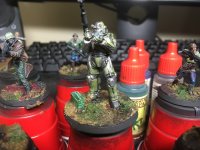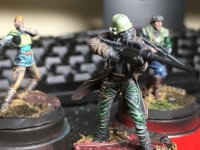MGibster
Legend
If you know anything about miniature painters, we tend to have a lot of unfinished or never started projects just lying around. Oh, yeah, we bought that beholder with some big ideas on how to paint that one big eye, we just had to have that giant robot as the centerpiece for our army, or maybe that squad of orcish grenadiers seemed like just the thing we wanted, but we got distracted by other projects, and eventually our big ideas faded from thought. I hadn't thought of it very much until my Zombicide: Dead or Alive Kickstarter arrived a few weeks ago. The basic game comes with 88 miniatures in total, but I backed the Kickstarter at the highest level I could, and suddenly I have 232 new miniatures. (I've painted 40 zombies so far, so I've put a dent in it at least.)
A lot of models are gray plastic, so a lot us refer to our unpainted collection as the gray tide or menace. In my case, it's not pathological, I'm not spending more money than I have, my house isn't cluttered, and it doesn't have an otherwise negative impact of my life. But I really, really need to get some of this stuff painted. I thought I'd make a resolution not to buy any more miniatures until I put a dent in the tide, but goals should be realistic, and that one would never last. I also don't want to paint just for the sake of painting, that's a chore, but at the same time I can't be beholden to one game or another. With that in mind...
Goal: To put a significant dent in the number of unpainted miniatures in my possession, as well as practice new techniques in order to improve my skills.
That's the goal, but what's the plan? You gotta have a plan.
1. Organize my unpainted miniatures. I have Warhammer 40k, Age of Sigmar, Star Wars Legion, Zombicide (multiple versions) Fallout: Wasteland Tactics, and a lot of miscellaneous miniatures that need to be painted. I really need to assess what I have before coming up with a final plan of attack.
2. Decide what skills I wish to practice on which miniatures. For hordes of zombies and Rebel troops, I'm probably going to go with what I think is the quickest way to get decent results, so we'll be using slapchop method for those. For centerpiece models I'll go for more traditional techniques and practice my glazing, layering, and wet blending. I'm going to try to actually paint eyes on things. Practice, practice, practice.
3. I'll post some pictures here as well as an explanation for what technique I tried. You'll see some ugly photos from time-to-time because that's what happens when you try something new. Sometimes you get results you weren't looking for, and that's okay, it's part of the learning process.
I encourage anyone else who enjoys painting miniatures to post here as well with examples of your work. Tell us what you did, hell, talk about color theory. I'm not a great artist, but I'd love to hear why you chose your color palette. If you've had to fight off your own gray tide, tell us how you did it.
A lot of models are gray plastic, so a lot us refer to our unpainted collection as the gray tide or menace. In my case, it's not pathological, I'm not spending more money than I have, my house isn't cluttered, and it doesn't have an otherwise negative impact of my life. But I really, really need to get some of this stuff painted. I thought I'd make a resolution not to buy any more miniatures until I put a dent in the tide, but goals should be realistic, and that one would never last. I also don't want to paint just for the sake of painting, that's a chore, but at the same time I can't be beholden to one game or another. With that in mind...
Goal: To put a significant dent in the number of unpainted miniatures in my possession, as well as practice new techniques in order to improve my skills.
That's the goal, but what's the plan? You gotta have a plan.
1. Organize my unpainted miniatures. I have Warhammer 40k, Age of Sigmar, Star Wars Legion, Zombicide (multiple versions) Fallout: Wasteland Tactics, and a lot of miscellaneous miniatures that need to be painted. I really need to assess what I have before coming up with a final plan of attack.
2. Decide what skills I wish to practice on which miniatures. For hordes of zombies and Rebel troops, I'm probably going to go with what I think is the quickest way to get decent results, so we'll be using slapchop method for those. For centerpiece models I'll go for more traditional techniques and practice my glazing, layering, and wet blending. I'm going to try to actually paint eyes on things. Practice, practice, practice.
3. I'll post some pictures here as well as an explanation for what technique I tried. You'll see some ugly photos from time-to-time because that's what happens when you try something new. Sometimes you get results you weren't looking for, and that's okay, it's part of the learning process.
I encourage anyone else who enjoys painting miniatures to post here as well with examples of your work. Tell us what you did, hell, talk about color theory. I'm not a great artist, but I'd love to hear why you chose your color palette. If you've had to fight off your own gray tide, tell us how you did it.


